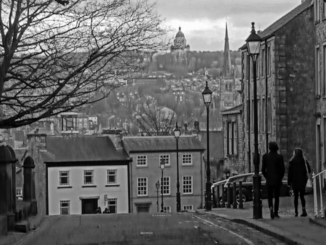We shall remain in Geneva in the 1980s for a little longer before moving around Lake Geneva in a clockwise direction in the 1950s. Does that make any sense? Our first photo this time is a classic view of the lakeside boulevard of Quai du Mont-Blanc.
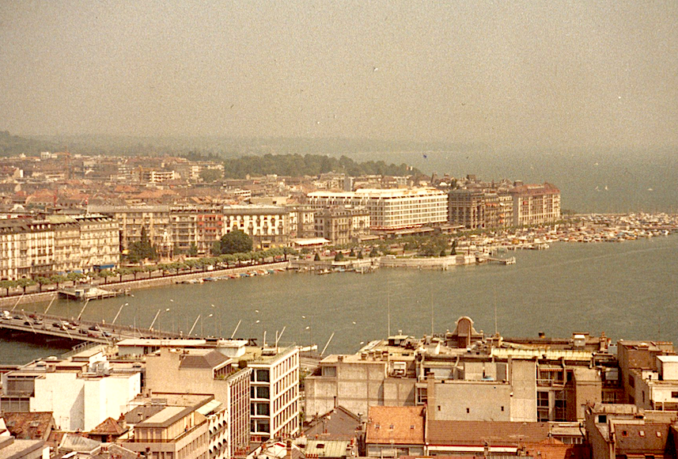
© Always Worth Saying 2023, Going Postal
Previously we’ve covered, left to right, the Hotel Paix Ritz Carlton, the Jardin des Alpes, the Brunswick Memorial, the Beau-Rivage Hotel and the distinctive white blob of the Noga Hilton Grand Casino (subsequently even tackier as a Kempinski Hilton, now a Fairmont Grand Hotel, yuk). We’ve also learned of the crescent-shaped promontory, the Pâquis, where Empress Elizabeth ‘Sisi’ of Austria was stabbed to death by an Italian anarchist in 1898.
Between the Beau-Rivage and the Hilton sit two smaller buildings. On the left, a branch of the Hong Kong and Shanghai Banking Corporation. Known as HSBC in the UK or, to old people like me, as the Midland Bank which HSBC took over in 1992 as the Midland struggled.
However, the branch at Quai du Mont-Blanc 15 isn’t your ordinary English market town high street establishment, not that many of them have survived. This HSBC is part of a private banking system which provides bespoke financial opportunities for high-net-worth individuals (HNWIs). What do we mean by high net worth? Traditionally it means those with liquid assets in excess of $1,000,000. By liquid assets, we mean cash in hand burning a hole in one’s pocket (so to speak) and pleading for a one-way ticket to Switzerland. Wealth not confined in bricks or mortar or a pension, mind you, pure unhindered spondoolies.
These days I would add a bit onto the million or better still add another zero. In other words, people who have no need for mutual funds but can invest as an individual. Important caveat – there is greater risk involved than in mutual funds. Past performance is no guarantee of future performance. Added to which, as financial advisor Mr Johnnie Bryan informed the Duchess of York all those years ago on a sun lounger in the south of France, these can go down as well as up.

© Google Street View 2023, Google
Next door sits the Hotel d’Angleterre, cheekily flying the EU flag despite the fact that neither the Swiss nor the Anglais are in the European Union. At its famous ground-floor conservatory-style Windows Restaurant, afternoon tea for two is yours for a mere £84. Small change if you’re staying in one of the Angleterre’s £4,000 a night suites. Stake and chips (excuse me, Wagyu rib eye steak, roasted salsify and French fries) is £132. A portion of mashed potatoes: £13.20. 1990 must have been a good year at Domaine de la Romanée-Conti as a bottle of their La Tâche Grand Cru plonk leaves the wine cellar for £10,000.
Before we sneer at Geneva and her super-rich we shall continue our walk along the Quai-side. When we get to the bend on the lake shore where Quai Wilson begins, there is something I must tell you.
On the far side of the Hilton and across Rue de la Cloche is a darker modern building which is the offices of another private bank. This time the honest gentleman of integrity at the National Bank of Kuwait. Next door, at 23, and with all the lower story blinds firmly closed, is the headquarters of Lilli Care, a home medical aid organisation and part of the big Pharma multinational Elli Lilly. Are you beginning to realise that the Hilton and the Ritz-Carlton are on the scruffy end of the street?
Number 25 houses Bergos AG, another private bank, this one part of the Berenberg banking group, founded by Hans and Paul Berenberg as recently as 1590 when the brothers left religiously intolerant Antwerp and established themselves in the Hanseatic port of Hamburg. One of the oldest banks in the world and the oldest privately owned bank in Germany, there are two branches in Switzerland which (in 2017) between them managed a cool £6,000,000,000 of assets.
After crossing the Rue Barton we come to one building covering Quai du Mont-Blanc numbers 27-31. It can be seen on the extreme right of photo one as a white building beside the marinas.
It is spilt into three ‘houses’ numbered 27, 29 and 31, and named, although it’s difficult to see on Street View and my French isn’t great, ‘Rolling Court’, ‘Beautiful Look’ and ‘High View’ respectively. With its pitched roofs, arches, columns and more arches, and detailed small square freezes depicting, perhaps, the trials of Hercules, 27-31 features in the Art Nouveau books. However, others attribute it to a Hoffmann-influenced modernism.
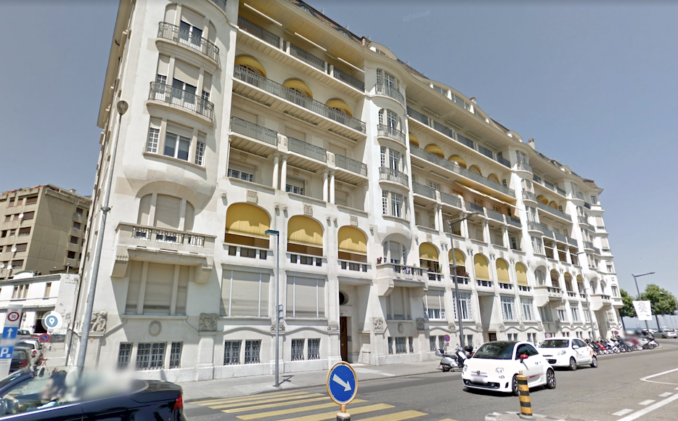
© Google Street View 2023, Google
But if Puffins think there is too much of a mixture of styles, some connoisseurs agree and classify the design as Eclecticism. Built in 1912 by Swiss architect Eugene Conte (1874-1964) on behalf of the Conte family, the 70ft high seven-story building was originally meant as apartments. Today it also houses business offices, again at the high end, many in the recruitment sector fishing for company executives and leaders in Switzerland and abroad.
Originally, perhaps because of the balconies, high windows and iconic views, it attracted an artistic set. Ferdinand Hodler lived in an apartment in number 27 from 1913 to his death in 1918. In 1961, his rooms were donated to Geneva’s Musee D’Art D’History (whose website ominously advises ‘automatically translated into English by a robot, please bear with the machines’) and are currently on display at their Boulevard Helvetique gallery – if the machines are to be believed.
On the corner of Number 31 sits the Marti Marine boat company. Here the building ends at Rue du Leman, as does the Quai du Mont-Blanc. Lac Leman is the proper name for lake Geneva and derives from Roman times when the lake was known as “Lacus Lemannus”, from the Greek “Limanos”, meaning port’s lake. In the Middle Ages, the lake was called “Lacus Losanetes” or “Lac de Lausanne”.
Previously Number 31 was also the gallery of Max Moos, the founder of Maison Moos, Galerie Moos and a patron of Ferdinand Hodler. Max Moos was born in Baden Wurttemberg in 1880. Son of Heinrich and Rosalie (Bloch), he was one of eleven siblings. After a peripatetic early adulthood, he settled in Geneva with his sister Hedwig in 1906 and opened a store selling picture frames and postcards on Rue du Rhone in the south of the city. In 1909, aged 28, he married Genevan Fanny Levy. By 1923, the Moos had expanded into Quai du Mont-Blanc 31 and in 1927 took extra space in the same building but in rooms which faced onto the neighbouring street and therefore were addressed as Rue de Leman 3.
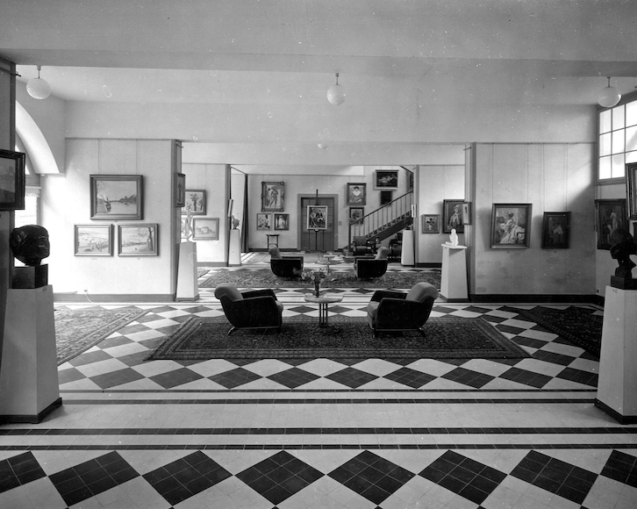
Intérieur de la Galerie Moos, rue du Léman, 3 c 1928,
Louis Pricam – Licence CC BY-SA 2.0
Above we can see the interior of Rue de Leman 3. On the right are the distinctive rectangular windows of the Rue Leman side, to the left are the arched windows of the Quai Mont-Blanc. The works on display seem traditional, even naive. By no means the only Moos in the art industry, Max von Moos of Lausanne was a contemporary who created more daring, even degenerate, modern works that can be viewed here.
In the 1930s Max Moos of Geneva specialised in auctions and exhibitions. The Moos spent the war in the United States, during which time their son Georges managed the galleries. Upon returning, there were more auctions but after gradually slowing down his activities, Moos died in his 97th year on 11th Oct 1976. With that, the gallery closed.
Having reached the end of Quai Mont-Blanc we shall pause for a second to reflect. It’s easy to laugh at the £11,000 bottles of wine, auctions of naive and degenerate art and private banks, but dwell on this.
While trying to find out what Lilli Care’s ‘home medical aid organisation’ meant, I fell across the swissinfo.ch website which informs the ignorant of the Swiss social care system. In Switzerland, the poverty line is drawn at £24,000 a year for a single person or £42,000 a year for a family of four. The gross median salary (ie sort of the average wage) is £70,000 a year. According to the prestigious Legatum Foundation’s prosperity index, Switzerland is the best place in the world for ‘Economic Quality’. Second best for enterprise, sixth best for living conditions and the second most safe and secure country in the world.
While we’re in the vicinity, upon mention of Rue du Rhone and suddenly realising all this was happening before the invention of the drone, where was photo one taken from? I would say it was snapped from the top of St Pierre’s Cathedral in the south of the city one or two streets from the aforementioned Rue du Rhone and close to the Musee D’Art D’Histoire.
A former Roman Catholic cathedral, St Pierre’s was converted into a Reformed Protestant Church of Geneva place of worship during the Reformation. It is known as the adopted home church of John Calvin, one of the leaders of the Protestant Reformation. Inside the church is a wooden chair used by Calvin.
Beneath the towers of St Pierre’s and on the other side of Rue du Rhone sits the Jardin Anglais. Rather like the man with the telescope watching the other family, the Swiss do seem to be somewhat obsessed by us. The park was created in 1855. In 1863 the building of the Pont du Mont-Blanc (bottom left of picture one) changed the park to its present trapezoid shape which covers six acres. The park hosts the Le Monument National and a L’horloge Fleurie (Flower clock), besides several pavilions, a sculpted bronze fountain by Alexis Andre and a coffeehouse. It also hosts the Fontaine des Quartre-Saisons, captured below by your humble author in the wasted days of youth (before the invention of unread blogs containing informative but unread articles) when he didn’t know what he was looking at.
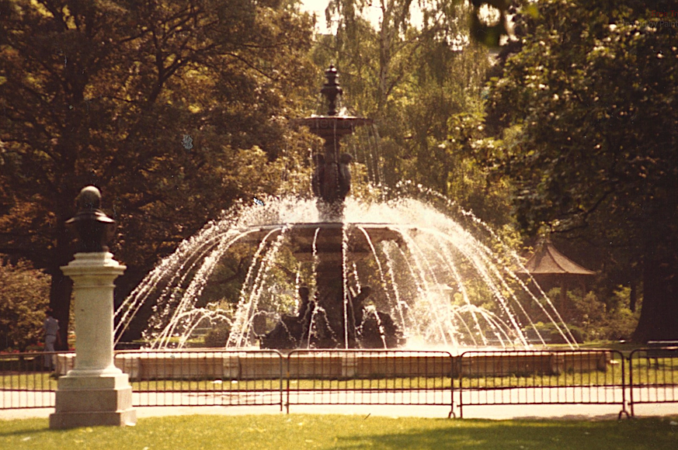
© Always Worth Saying 2023, Going Postal
© Always Worth Saying 2023



